The day I discovered the deliciousness of cauliflower leaves changed my life. Ok, that’s not true at all. But the buttery, nutty flavor hidden in a silky cabbage texture did surprise me. It also didn’t happen very long ago, leaving me with some shame over all the cauliflower leaves that went thoughtlessly into the trash.
I grew up, as I’m sure we all did, hearing about how we shouldn’t waste food. I didn’t think about it much, especially if it was something I didn’t particularly like eating. But I realized as I got older (and lived with other people) that maybe those lessons had sunk in. It’s traditionally been ‘uncool’ to eat the tougher cuts of meat, or save onion ends for the stock pot. Why is wastefulness cool?
Did you know that the world wastes 33% of human edible food? It’s in every part of the food chain, from farmers plowing extra cauliflowers back into the field to you discovering moldy mystery food in the back of the fridge. Besides the obvious, food waste contributes to global warming and local and international food crises. Every food we buy, whether it’s homemade or ordered, has an impact on the world.
Sometimes it feels like problems are so big there isn’t much we can do about them. It’s easy to ignore them because the negative impact seems much greater than any of our positive actions.
But sometimes, when issues are tackled from all sides, there’s a real opportunity to make an impact. Whether it comes from chefs, policy makers or us consumers and home cooks, tackling food waste doesn’t seem so impossible. I have some suggestions about cutting food waste at home … after all the pretty pictures of the wastED pop up.
wastED, the food waste pop up
wastED was in residence at the Rooftop at Selfridges in London. New York chef Dan Barber, the creator, wanted to draw attention to the wastefulness in our food system, and how with practical and creative choices, even we can make a difference. Every dish on the sharing plates menu highlighted a food waste product and put it to good use. From the tender leaves on top of a kale to the mounds of fruit and vegetable pulp leftover from juice bars… the menu included lots of inventive dishes with a conscious twist.

A sneak peek of what to expect from the wastEd menu.

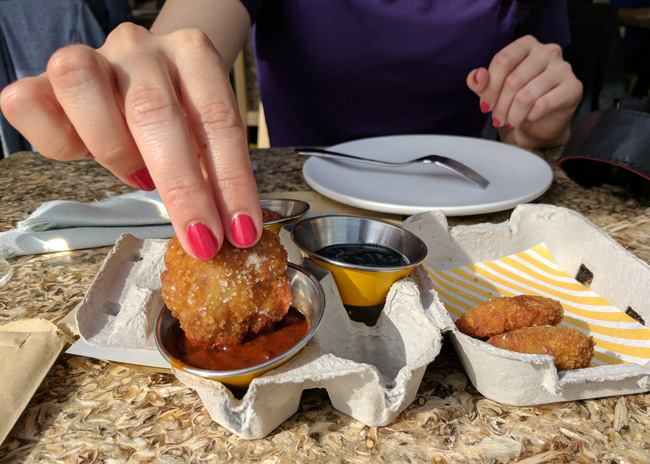
His and her’s dippers. Veal nuggets with 3 sauces, charcoal mayonnaise, tomato relish and smoky ketchup.

Bread made with spent bran and barista milk (a-maazing), and pea-skin crackers served with three spreads, including Napoleonic butter (the OG margarine), ricotta and whipped jamon drippings.
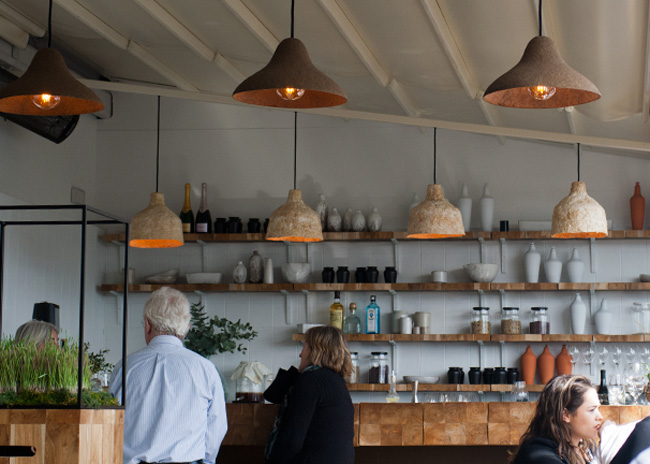
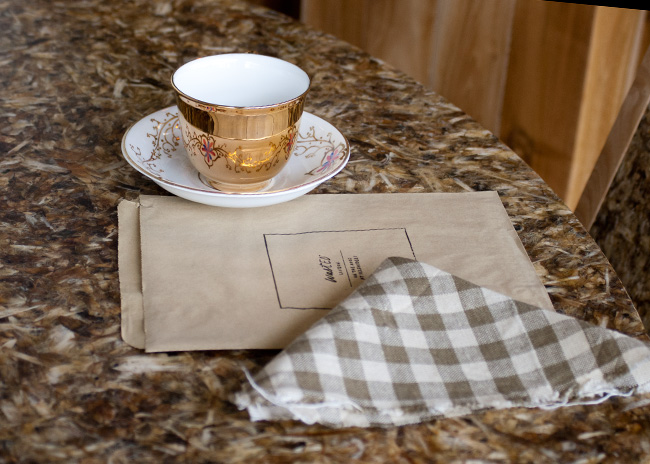
Even the decor was accented with upcycled waste products and salvaged wood. The tables, crafted from artichoke thistle and lamps made of seaweed and mushrooms looked like they could have come straight from a Scandi boutique.
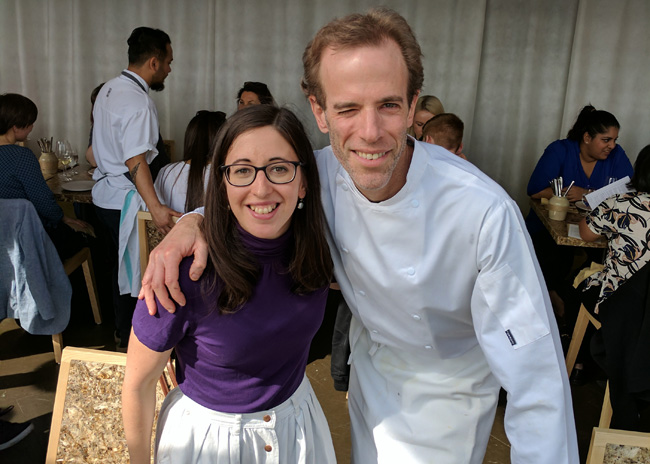
We even got to meet the chef! Dan Barber, in residence.

Trendy cod cheeks (…and the rest) with a broken rice kedgeree.

Beet and vegetable pulp burger, made with the leftovers from juicing machines. Topped with bacon from waste fed pigs, it was nestled into a bun made with leftover bread. On the side? Beet runoff ketchup and picalilli. The vegetables came straight from local juice bars.
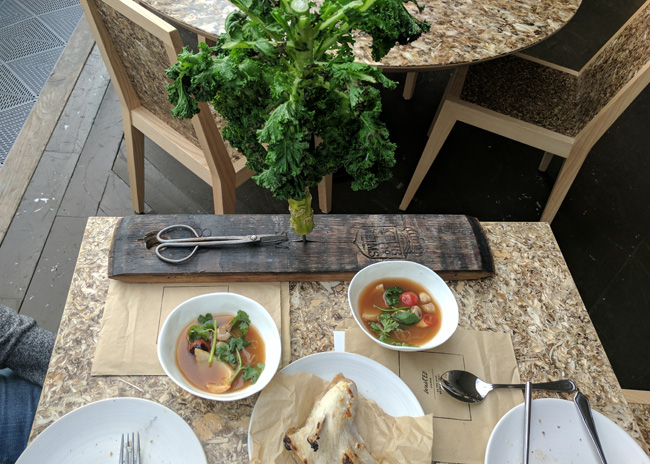
A kale tree! Tender and sweet, these young leaves get left behind in the field because it’s too labor intensive to harvest them. These trees came from Riverford, the organic veg box provider. We trimmed the delicate leaves to eat alongside a fantastic delicately flavored crab shell broth, with crab noodles and zucchini ends.

What can we do to reduce food waste?
Obviously, opening a sellout pop up restaurant in Selfridges is probably a bit out of the reach for most of us. The lessons from it, though, are pretty easy to try at home.
Many vegetables also more edible bits than we’ve been conditioned to recognize. You can save vegetable scraps for stock, cook up cauliflower leaves (they’re really good!), and save your broccoli stems for stir fries or veggie bakes. Celery leaves, by the way, are totally edible and can go in with regular celery. Chop up herb stems and add them in while you’re cooking, or add them to the stock pot.
Here’s a controversial one. Stop buying so many spices. If a recipe calls for an unusual spice that you’ve never before used and you’ll probably never use again, why bother? You probably aren’t going to notice it’s missing, and most spices are easy to substitute. Otherwise, start researching recipes to use that sumac that’s been going stale in the back of your spice rack.
If you’re a meat eater, try different cuts, or different meats altogether. Have you ever slow cooked lamb breast? (By far, the cheapest cut of lamb you can get.) What about oxtail? Make yourself a big pile of home-cooked chicken wings — they are dirt cheap outside of the States. There are plenty of cuts that don’t get attention, especially on supermarket shelves. Some cuts, like lamb breast, require longer cooking times, but the reward is lower-cost, rich and flavorful food that would otherwise go to waste.
Male goats are slaughtered early on in an economy where goat cheese is prized, but many see goat meat as weird. If you eat goat cheese, it’s worth thinking about what that means for the goats. Some great entry foods are goat curry (if you like curry, that is) or goat Merguez sausages.
Deep freeze
Freezers are our friends, too. Bread freezes well, especially if you’re going to toast it. Instead of buying bread crumbs, take the sandwich-unworthy ends and blitz them up. They freeze well, too.
You can turn bones and wilted vegetables into stock and then freeze it if you can’t use it all. Store those bones and less-than-lovely veggies in the freezer until you’re ready to boil them to smithereens.
Other foods you can freeze:
- nuts
- tortillas
- eggs, outside of their shells
- milk, just shake it up once defrosted
- chilli peppers – chop them after a few minutes out of the freezer, before they fully defrost
- berries and bananas (peeled!) for baking, smoothies, oatmeal (porridge) or eating frozen
- half-cans of food like tomatoes, coconut milk, refried beans – just make sure to take it out of the cans and store in an air-tight bag
I could go on with even more suggestions on how to cut down on food waste, and if you want more ideas, just ask! (Or Google, because there are lot of great suggestions out there.) No one is perfect, but making a conscious decision to change your habits is a good first step to saving money and helping fix the food imbalance.